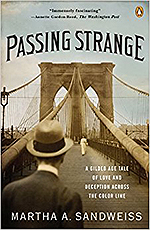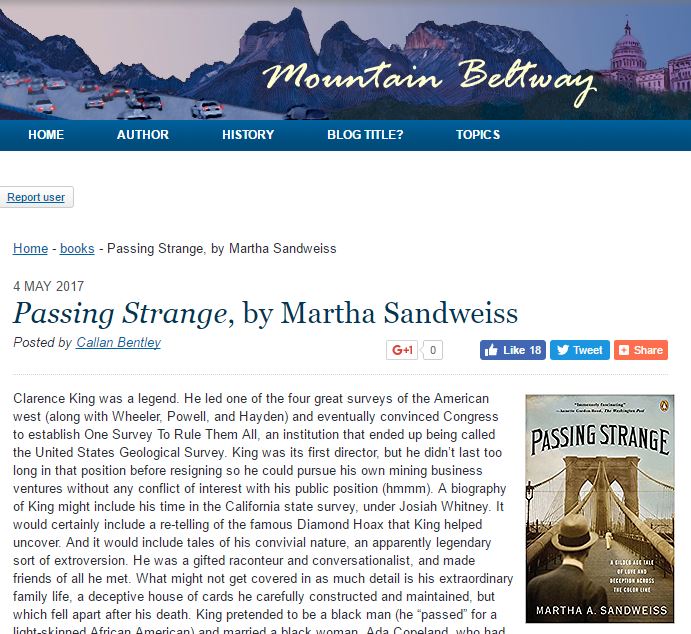 Clarence King was a legend. He led one of the four great surveys of the American west (along with Wheeler, Powell, and Hayden) and eventually convinced Congress to establish One Survey To Rule Them All, an institution that ended up being called the United States Geological Survey. King was its first director, but he didn’t last too long in that position before resigning so he could pursue his own mining business ventures without any conflict of interest with his public position (hmmm). A biography of King might include his time in the California state survey, under Josiah Whitney. It would certainly include a re-telling of the famous Diamond Hoax that King helped uncover. And it would include tales of his convivial nature, an apparently legendary sort of extroversion. He was a gifted raconteur and conversationalist, and made friends of all he met. What might not get covered in as much detail is his extraordinary family life, a deceptive house of cards he carefully constructed and maintained, but which fell apart after his death. King pretended to be a black man (he “passed” for a light-skinned African American) and married a black woman, Ada Copeland, who had been born a slave just prior to the Civil War. King’s nom de mariage was “James Todd,” and so Ada became “Ada Todd,” assuming a last name she didn’t know was fiction. King traveled extensively for his work as a geologist, and basically lived out of hotels and clubs most of the time, except when he was home in New York, wherein he transformed into James Todd, home after a cross country journey as a railroad porter. He and Ada had a slew of children, some of whom survived and some of whom died young. When King contracted tuberculosis and died, he sent Ada a letter confessing his real name. He had influential friends provide modest, sustainable financial support to Ada and her children, who was now Ada King. Dependent on the money for the sake of her children, she kept relatively mum about the situation, but quietly pursued attempts to recover a trust fund that King had lied to her about. Eventually, three decades after Clarence King’s death, this culminated in a lawsuit that, while unsuccessful, brought the cross-racial marriage into the public awareness. Martha Sandweiss documents this surprising history in Passing Strange. I found the book to be compelling, well-paced, and astonishingly meticulously researched. It’s a fascinating look behind the curtain at one of the most famous American geologists, as well as an insightful examination of the state of race relations in the half century after the Civil War. Recommended.
Clarence King was a legend. He led one of the four great surveys of the American west (along with Wheeler, Powell, and Hayden) and eventually convinced Congress to establish One Survey To Rule Them All, an institution that ended up being called the United States Geological Survey. King was its first director, but he didn’t last too long in that position before resigning so he could pursue his own mining business ventures without any conflict of interest with his public position (hmmm). A biography of King might include his time in the California state survey, under Josiah Whitney. It would certainly include a re-telling of the famous Diamond Hoax that King helped uncover. And it would include tales of his convivial nature, an apparently legendary sort of extroversion. He was a gifted raconteur and conversationalist, and made friends of all he met. What might not get covered in as much detail is his extraordinary family life, a deceptive house of cards he carefully constructed and maintained, but which fell apart after his death. King pretended to be a black man (he “passed” for a light-skinned African American) and married a black woman, Ada Copeland, who had been born a slave just prior to the Civil War. King’s nom de mariage was “James Todd,” and so Ada became “Ada Todd,” assuming a last name she didn’t know was fiction. King traveled extensively for his work as a geologist, and basically lived out of hotels and clubs most of the time, except when he was home in New York, wherein he transformed into James Todd, home after a cross country journey as a railroad porter. He and Ada had a slew of children, some of whom survived and some of whom died young. When King contracted tuberculosis and died, he sent Ada a letter confessing his real name. He had influential friends provide modest, sustainable financial support to Ada and her children, who was now Ada King. Dependent on the money for the sake of her children, she kept relatively mum about the situation, but quietly pursued attempts to recover a trust fund that King had lied to her about. Eventually, three decades after Clarence King’s death, this culminated in a lawsuit that, while unsuccessful, brought the cross-racial marriage into the public awareness. Martha Sandweiss documents this surprising history in Passing Strange. I found the book to be compelling, well-paced, and astonishingly meticulously researched. It’s a fascinating look behind the curtain at one of the most famous American geologists, as well as an insightful examination of the state of race relations in the half century after the Civil War. Recommended.

